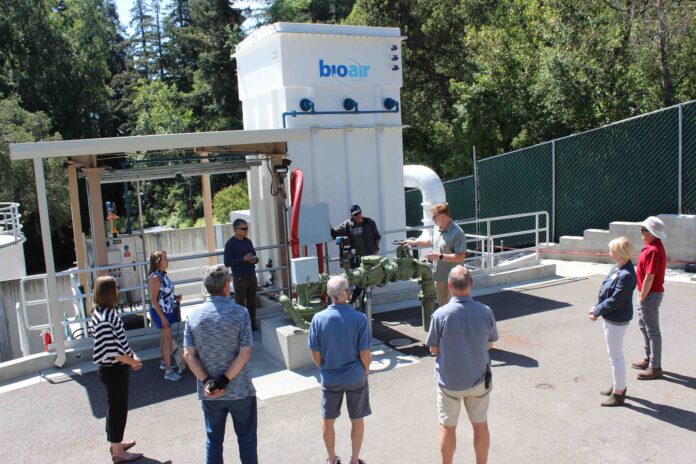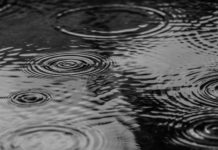
It costs big bucks to ensure one of life’s essential components is fit for human consumption. And on May 25, local officials and media got to taste the $3.5 million upgrade results to the Scotts Valley Water District’s Orchard Run Water Treatment Plant, leaving memories of the previous, more undesirable, liquid in the dust.
“Their laundry machines didn’t last long,” said Ruth Stiles, SVWD’s board chair, recalling the slimy brown ring residents became familiar with around washbasins. “We want to have good-tasting water.”
The improvements—including a wastewater tank, high-pressure pipes and an exhaust deodorizer—have taken quality control to the next level. Still, many of the 4,000 customers aren’t yet fully aware of the changes.
Before, things were so bad that the hydrogen sulfide gas that drifted up from the depths would burn the trees above the treatment facility, one of three similar plants run by the district.
SVWD’s operations manager David McNair said he enjoyed friendly disagreements with folks at the Scotts Valley Food and Wine Festival last year, where he was giving out samples.
“This is not Scotts Valley water,” they’d say.
So last week, to spread the word about Scotts Valley’s new H20 reality, attendees were directed towards three clear jugs of water. The instructions were to vote for the one thought to be “Scotts Valley” water. In my opinion, they all tasted the same; however, some participants claimed they could identify which receptacle contained the local varietal. Councilmember Jack Dilles wandered over to Jug No. 2.
“This is good,” he said. “I’m actually thirsty.”
As the votes were tabulated, McNair led the group up the hill to point out the Orchard Run Well, permitted in July 2018. It’s 1,400 feet deep and pulls mainly from the Butano Aquifer. The Bio Air scrubber behind serves as an exhaust system for the plant. Mayor Donna Lind remarked that it’d been a considerable improvement compared to the previous situation.
“You could smell it across the freeway,” she recalled.
The group also got a primer on what the facility does during the tour. After the liquid has been coursing hundreds of feet below the Earth’s crust, a lot must happen before it tastes like the good old-fashioned H20 we’ve come to enjoy. It’s piped through a series of receptacles, agitated with physical objects, air is pumped through it and finally, it’s bathed in chemicals. When raw water enters the facility, it’s dosed with orthophosphate (a corrosion inhibitor that eliminates lead), oxidized, runs through plastic balls, and shocked with chlorine, eliminating the germs that cause diseases like hepatitis and typhoid. At the heart of the property, an enormous generator powers the whole operation, pushing water across the newer section of the plant with around 160 pounds of pressure.
Then, it goes through a pressure filter made of sand and anthracite (hard coal—another carbon). That used to be the end of the process. But now—thanks to the new additions—the water gets a coconut shell bath, too.
These 10-foot diameter cylinders, each of which can process 800 gallons of water a minute, are a significant highlight of the renovations.
Both tanks hold 20,000 gallons of water and are full of coconut shells, a carbon treatment considered primo for purification. The district expects to have to replace the shells every 10 years.
Councilmember Dilles asked if the concrete pad underneath could withstand the effects of shifting tectonic plates. McNair confirmed they had earthquakes in mind when it was designed.
“There’s also a new analyzer,” McNair added, referring to the technology that ensures the right amount of chlorine is introduced. They now have a wastewater outflow connection as well.
The time came to reveal the water people thought they were drinking. It turned out that half of the voters got it right and picked Jug No. 1 as Scotts Valley water, with seven votes. Six people selected Jug No. 2, which was bottled water. Just one person voted for Jug No. 3, which was brought in from another water district. District officials declined to expose the source of Jug No. 3.












